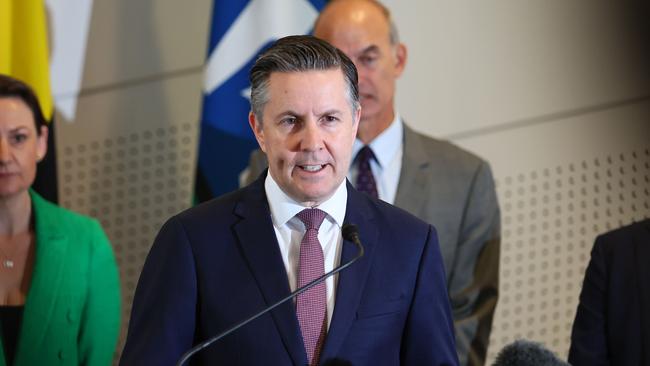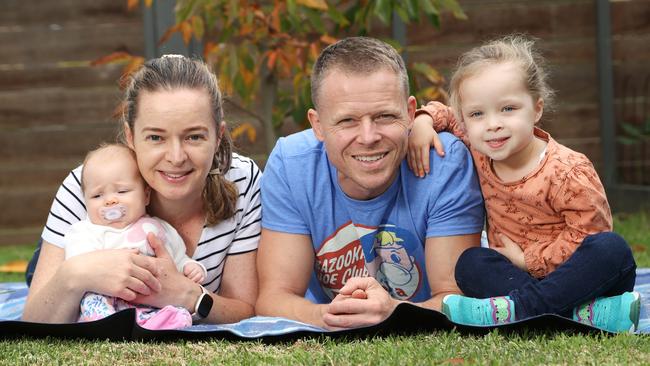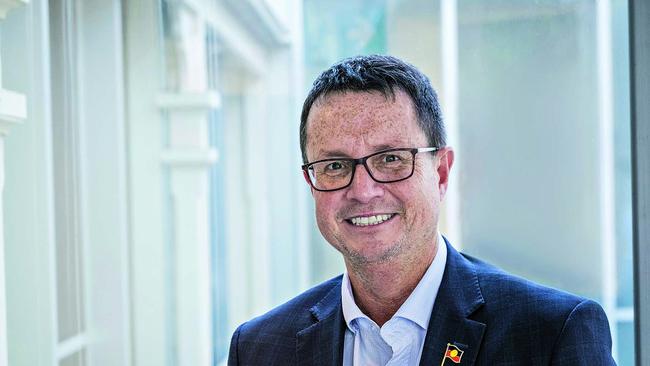Health fund premiums set to soar: How to cut costs
Private health cover costs are set to rise after the government backed down on a key money-saving measure. Compare prices in our health premium calculator to lower your fees.

Health
Don't miss out on the headlines from Health. Followed categories will be added to My News.
Health funds claim premiums will soar after the federal government backed down on a measure that would have saved health funds on the cost of common surgical items.
From July 1, a range of common surgical items like sponges, staples, sutures, and glues were to have been removed from a list of devices health funds must pay for.
But now the funds will have continue paying for them, at rates set by the government.
The insurers claim they are being hard done by as large private hospitals often purchase the items for less than the price the government insists they charge – and keep the savings as profit rather than passing them on to health fund members.
Health Minister Mark Butler said the government was abandoning the plan because he feared patients may have faced new out-of-pocket expenses imposed by hospitals to cover the cost of the devices.
“The removal of these items from the Prescribed List raised questions over whether those costs would now be carried by patients with private insurance through higher out-of-pocket fees, or private hospitals,’ Mr Butler said.

He also justified the decision by pointing to a major decline in private hospital profits which fell from 9.6 per cent in 2017-18 to just one per cent in 2021-2022.
Seven in 10 private hospitals were now making a loss, he said.
“To maintain access to quality healthcare and to provide certainty to private hospitals
and patients, the cost of these common surgery items will continue to be funded through
the Prescribed List,” he said.
Private health insurance lobby group Private Healthcare Australia (PHA) warned the decision would push up health fund premiums.
“The Federal Government’s decision to wind-back the planned removal of general use items from the Prescribed List of Medical Devices and Human Tissue (PL) on 1 July is likely to impact the cost of private health insurance premiums for 15 million Australians,” PHA CEO Dr Rachel David said.
With the wind-back of these reforms, PHA wants the government to impose alternative brakes on health insurer’s costs, she said.
Use our calculator below to compare funds:

Insurers want an enforceable Code of Conduct to prevent upselling of general use items by sales representatives in operating theatres, and mandatory reporting of any kickbacks paid to hospitals or doctors.
It says whistleblowers have exposed these practices are occurring in hospitals.
Health funds also want a range of measures to remove incentives for the overselling and overpricing of commonly used medical items.
Dr David said over the past year all health funds offered to pay private hospitals new funding arrangements for hundreds of general use items used in surgery, such as sponges, staples and catheters.
The removal of these items from the PL was recommended by an Ernst and Young report commissioned by the Department of Health and Aged Care, which found that paying for every single individual item is inefficient and incentivises hospitals to use more devices, she said.
Catholic Health care Australia welcomed the decision.
Removing funding for general use items would have pushed up out-of-pocket costs for patients and put further strain on financially struggling hospitals, particularly in regional areas, Mr Kara said.
“Surgeries which use lots of these items - including breast cancer procedures, caesarean births and bariatric surgeries - could have cost patients thousands of dollars extra out of pocket if the change had gone ahead,” he said.
HOW TO SAVE ON PRIVATE HEALTH COVER
The price of top cover health insurance policies has cracked $10,000 a year for a family, as providers’ profits soar, it can be revealed.
And health insurers are warning gold cover is fast becoming “unsustainable”.
After being granted a massive 14.99 per cent price hike at the start of this month, HCF’s Hospital Premium Gold policy with a $250 excess has jumped to $10,077 a year in Victoria, making it the most expensive in the country.
The premium rise on this policy is five times higher than the “average” 3 per cent increase Health Minister Mark Butler said he had approved.
It’s not the only exorbitantly-priced policy on the market.
Our investigation identified a further 43 policies that now cost families more than $9000 a year.
For singles, AHM’s Gold Advanced Hospital policy with a $500 excess was the most expensive costing $5250 per year in Victoria. It leapt in price by 9.9 per cent.
But we found if consumers shop around, they can buy Gold cover for half that amount.
St Luke’s health fund is offering a gold policy for as little as $5172 per year for families ($2589 for singles), while Mildura Health fund is charging $5410 ($2705 singles) a year.
Health insurance is now so expensive, it could be cheaper for people to self-fund some common surgeries like cataract surgery which typically costs $4400, repair of hernia at $5200 to even excision of a breast tumour at $7100.
Private Healthcare Australia chief Dr Rachel David said gold cover was on track to “become unsustainable as a long term option for people unless the system is reviewed”.

Consumers were commonly only taking out top cover when they needed access to very specific forms of high cost care like long term inpatient mental health care or bariatric surgery.
“So effectively what that means is that top hospital cover is a level of cover for people who know they’re going to claim and from an actuarial perspective, this means that the cost is going to spiral upwards very fast,” she said.
With premiums soaring and in a tough, cost-of-living environment, silver health cover overtook gold as the most popular level of health cover in 2022.
The number of Australians covered by Gold cover fell from 39 per cent in December 2020 to 33.2 per cent in December 2023 - and 37.6 per cent of people now hold silver-level health insurance.
Much fanfare surrounded Mr Butler’s announcement in March of an industry “average” premium hike of 3.03 per cent, as health insurance costs were “rising at a much slower rate than the increase in wages, the age pension and inflation”.
However, we can reveal HCF was still able to hike the price of its gold cover by 15 per cent, nearly $100 a month in NSW, and by 14.99 per cent in Victoria and Queensland, because it fell within the 3 per cent industry-wide average.
In a statement HCF said “gold policies also cover a higher risk member population with more complex care needs and premium increases have been necessary to reflect the escalating costs of delivering this healthcare”.
AHM said of its high cost gold singles policy “we have worked hard to ensure this year’s is as low as it can be, despite rising health costs in the private system”.
“Gold products cover more expensive procedures such as pregnancy and psychiatry, and their premium increases are generally higher than the average,” a spokesperson said.
The fund said in the 2023 financial year, families using this cover received benefits on average worth $11,904 while paying annual premiums of only $6904.

In NSW, 266 health fund policies recorded a price hike higher than the 3.03 per cent average and 31 polices rose by over 9 per cent.
Two policies - Medibank’s Silver plus Advanced and HCF’s Accident only Basic cover -actually went down in price in NSW.
In Victoria, 269 health fund policies recorded a price hike higher than the 3.03 per cent average and 31 polices rose by more than 9 per cent.
In Queensland, 257 policies rose in price by more than 3.03 per cent and 26 increased by over 9 per cent.
In South Australia, 262 policies rose by more than 3.03 per cent, including 22 that rose by more than 9 per cent.
Mr Butler said he “wasn’t prepared to just tick and flick the claims of health insurers, as the Opposition was urging me to do. I asked insurers to go back and sharpen their pencils and put forward a more reasonable offer for the 15 million Australians with private health insurance,” he said.

The rises, which took effect on April 1, are the third premium jumps in 15 months for customers of Medibank and the second rise in five months at HCF, nib and Bupa.
Australian Medical Association (AMA) analysis shows that health insurers have recorded a 50.2 per cent increase in profits over the four years to June 2023.
The industry made a collective profit of $2.2 billion in the year to June 2023 — a 109.8 per cent increase on the previous financial year.
But the amount insurers paid out in medical services and hospital treatment benefits increased by just 3.6 per cent and 8.1 per cent respectively, the AMA found.
AMA president Professor Steve Robson is calling for health funds to be required to return 90 per cent, on average, of premium dollars paid each year back to the consumer in the form of rebates and benefits.
In 2022-2023, the organisation’s private health insurance report card found the proportion of premium revenue insurers returned to their customers fell to 81.6 per cent — down from 88.02 per cent in 2018–19.
‘IT’S REALLY FRUSTRATING’
Teacher and mother of two Andi Carlisle is the only member of her family to have hospital cover.
The 36 year old took out a Basic hospital policy with Teacher’s Health to avoid a tax penalty and when she was planning a family but has never used it, even when she had her children.
“I was talking to friends and they said even with private health insurance, it still cost them close to $10,000 to have a baby at a private hospital. That’s outside of our budget,” she said.
“If you’re paying private in my opinion, everything should be paid (covered). I personally find it really frustrating that you have health companies making such huge profits.”
The Melbourne mum also has extras cover with Medibank which she does consider value for money.

“My extras I can use. I was a competitive powerlifter so I always used to go to the osteo and the dentist,” she said.
Her family has ambulance cover privately through the Victorian ambulance service rather than through the health insurance companies.
“There’s really good public hospitals nearby that do take care of you in a quick turnaround if there’s an emergency,” she said.
A public hospital treated her daughter Selena’s hip displaysia, Ms Carlisle said.
Her husband Marquis, a personal trainer who does not have health insurance to avoid tax, needs a hernia operation that will cost around $8000 in the private system. The wait list in the public system for the operation is years long, she said.
“If he could have had insurance, that’d be great. He’s a lot more accident prone than me,” she said.
More Coverage
Originally published as Health fund premiums set to soar: How to cut costs



